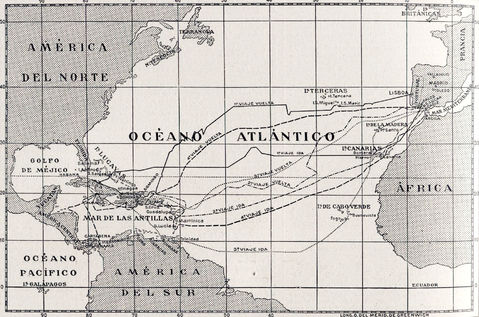
Most school children know the story of the First Voyage of Christopher Columbus though its interpretation now ranges anywhere from the triumph of the spirit to persevere in the Age of Discovery to some corrupt form of economic plundering in the Age of Imperialism. History is seldom clean. It is full of flawed characters and mixed motives where the good and bad of actions are bound up in the ideals of the age. Just like today and tomorrow.
Columbus had it all wrong but that is what makes him such a heroic figure. His scheme was farfetched. Convince Isabella of Castile, founder of the Holy Roman Empire, that a westward route from Iberia, modern Spain, to the Indies, Southeast Asia, would be a shorter trek to the lucrative spice trade than going overland through Arabia which was full of pirates and even worse high tariffs. The prevailing wisdom of the day was to give most voyages of such high risk a single vessel to minimize losses in the face of probable failure. But, the Queen gave Columbus three ships. The Santa Maria was a large carrack used for transporting cargo. The Pinta and the Niña were caravels, small highly maneuverable boats. They left from a common port, Palos, but each ship had a different keel, rudder and riggings. They were stocked with diverse provisions and took contrasting courses. Columbus’ estimations of the circumference of the earth were so far off that it made dead reckoning, navigating by calculating the position of the craft from its speed and its relative place on a map, impossible. Nothing was where it was supposed to be, including the other ships. When he did “accidently” arrive in the Caribbean after six weeks at sea, he believed he had found the Indonesian archipelago and therefore called the locals “Indios”; hence the common term for Native Americans – Indians.
Though the voyage encountered the normal intrigues of local insurrection, attempted mutiny and the occasional bit of foul weather, upon his return to his monarch, Columbus was named the Admiral of the Ocean Sea and Viceroy and Governor of the Indies. On the hopes of finding riches and new lands, Isabella promptly raised a fleet of seventeen vessels and ordered Columbus to make a Second Voyage the next season. He established an encampment and trading port at Hispaniola, the present-day Dominican Republic, from which he governed the region. Though the enslavement of the indigenous peoples and the transmission of European borne diseases like small pox are reprehensible lessons of history, it was his tyrannical treatment of Spanish settlers and his insistence that the Crown give him the agreed upon ten percent of all profits made from his found lands that brought about his undoing.
Ultimately, he would make four voyages, and though he established the reliable trading routes, it was his contemporary, Amerigo Vespucci, chief of navigation of Spain, for whom the content is named – America. Lest we feel sorry, there are over three dozen cities named after the explorer as well as national holidays throughout the Americas. Over the following three hundred years, the Spanish ruled, or plundered, depending on the angle of view, the “New World” for the glory of the empire. More importantly, Columbus discovered hidden rules about ocean currents, trade winds and climate that would become invaluable for future explorers. Less than a century later, standards and systems would be introduced into map making prompting a revolution in world trade still underway.
We remember Columbus as much for how he “discovered” America as for the fact that he found it at all. To the end, he believed that he had followed a westward passage and arrived in Asia. Whether intentional or not, he diversified his approach when faced with insufficient information about his destination. In possession of new and emergent knowledge that comes only through experimentation, he quickly streamlined his approach to minimize the risk and maximize the reward. Columbus left us a route and a map to follow not only to the places he found but also to the way in which he found them.
Jeff DeGraff
Connect with me on Twitter
Join me on Facebook
Visit InnovationYou.com
